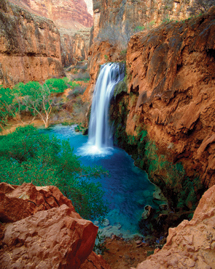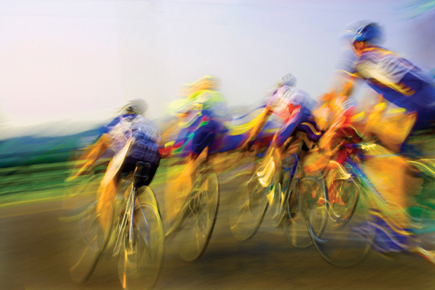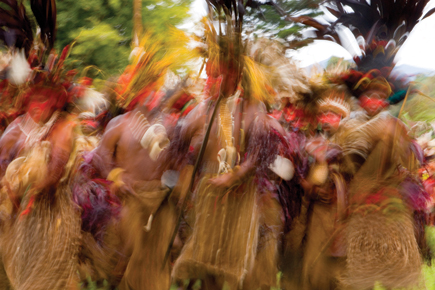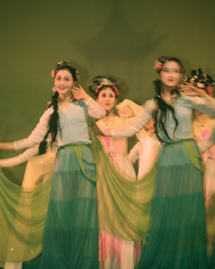Time Travel; Using Still Images To Imply Motion
Photography can do two things that no other artistic medium can do: It can freeze motion so we are able to examine every detail in a fast-moving subject, thus revealing things that our eyes could never catch; and it can blur the same subject to express the fluidity and aesthetics of motion. When you blur a subject with a long enough shutter speed, it blends the background with a unique mixture of color as if an impressionist painter interpreted the image instead of a camera. No matter how many times you try this technique the results are always a surprise. It's impossible to predict in your mind's eye exactly how the final image will look. That's part of the fun.
Havasu Falls: 1/4 sec, f/32 |
|
 |
|
|
The shutter speed that will give you the most artistic type of blur is dependent
on several factors. There are four parts of the equation that go into the thought
process in creating blurred images, and they interact with each other in ways
that make it impossible for me to give you a guarantee that any particular shutter
speed will be the right one for the effect you want to achieve.
The Four Factors
The four parts of the equation are: (1) the speed of the subject, (2) the motion,
if any, of the camera, (3) the lens choice, and (4) the shutter speed.
Cyclists: 1/6 sec |
|
 |
|
|
The speed of the subject is obviously critical, but also very important is
the subject itself. For example, if you blur a
5-year-old child on a tricycle as much as an adult on a racing bike, the results
would look silly. Similarly, if you blur a jogger as much as a Formula 1 race
car it wouldn't make sense. Artistic license can be used, of course, to
express certain concepts, which can include humor and exaggerated speed. But
keep in mind that if you want to realistically express the movement of a subject
the amount of blur you add should make visual sense.
The motion of the camera is also a factor. Are you panning with the subject
or is the subject moving past a motionless camera? If the camera is moving with
the subject, there are two things to consider--the blur of the background
and the blur of the subject. Panning is a favorite technique of mine because
it's a great way to imply motion. The juxtaposition of a subject that
is somewhat blurred against a background that is very blurred makes for a dramatic
image and is one of the best ways to imply motion in a still picture.
Dancers: 1/5 sec |
|
 |
|
|
The lens is an important factor as well for this reason: telephoto lenses
magnify movement because of their narrow angle of view. Wide angles encompass
so much in the frame that movement, even of a relatively fast-moving subject,
seems slower than it really is. A shutter speed of 1/4 sec will show significant
blur of a waterfall, for example, with a 300mm lens, but the same waterfall
taken from the same shooting position with a 16mm wide angle will barely show
blur in the water. I would use a full 1-second exposure if you want to see the
water turned into the soft, white, "cotton candy" look that is so
artistic.
The shutter speed, then, depends on a lot of factors, including your taste.
Let me give you some guidelines (see sidebar) that will get you started, but
keep in mind that it's important to keep monitoring your LCD so you can
see exactly what you're doing.
Ultimately, the shutter speed you use comes down to an educated guess. Even
with years of experience it's hard to know precisely which speed will
work for any given subject. The immediacy of the feedback we get from digital
cameras makes it a lot easier, though, in assessing the correct speed. All you
have to do is try one, and if it's too fast or too slow make the adjustment
and shoot again. Of course, if you are shooting a once-in-a-lifetime event,
that puts a different spin on the situation. Then it's good to have some
practice under your belt so your educated guess is more educated and less guesswork.
China: 1/4 sec, multi-exposure |
|
 |
|
|
Sharp Juxtaposed With Blur
For many blurred images, a tripod should be used to provide a sturdy support
for the camera. This may at first seem unnecessary, but it is essential for
some situations. Waterfalls, oceanscapes, and flowers, for example, usually
require a tripod because this sets up a dramatic contrast of sharp objects juxtaposed
against blurred ones. Moving water over unmovable rocks is the classic scenario.
A flower blowing in the wind next to a fallen log is another. When I was in
Italy recently I took a 20-second exposure at night of waves crashing against
the breakwater just below a coastal village, and the mixture of the abstracted
water with the tack-sharp rocks and buildings was quite dramatic.

















































